
DETERMINING BANKROLL REQUIREMENTS
So far you have learned how video poker started and grew. You have learned how to play video poker, including return, house edge, and variance. You have learned about how randomness actually works. You have also learned about several categories of video poker games that are available today.
Since those early days, video poker has steadily grown, until it is now available in virtually every casino where Las Vegas style gaming is allowed. What started as a single game has multiplied into what now is dozens of different variations of the game. They can be grouped into several basic categories.
In this chapter you will learn how to determine the size of bankroll that you will require to play many of the different varieties of video poker games in the casinos today. Some of the results may shock and amaze you.
Are you ready to begin?
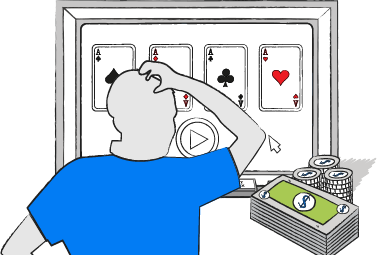
Great, let’s go.
![]()

GENERAL RULES
One of the biggest mistakes made by casino gamblers is bring too little money with them. Many come to play video poker with a woefully small gambling stake. It is no fun to run out of money. It is especially no fun to run out of money when you are still in the first day of a three day trip to the casino.
In this section you will learn the basic rules that influence the size of the bankroll needed to sustain your video poker playing sessions. While some of the rules are quite intuitive, others seem to defy normal logic.
Okay, on to the general rules.

![]()
WHAT A BANKROLL IS:
In chapter 2.3 we touched on what a bankroll is and what it is not. Now let’s look at it in a bit more detail. A bankroll for video poker is a sum of money that has been saved and put aside for the sole purpose of playing casino games. It can be kept separately in a safe at home. It can even be kept in a separate bank account where it might collect a few cents of interest. The main point is the gambling bankroll must be totally separate. It cannot be part of any money that may be required for everyday living expenses.
I have heard this separate account being called a 401G account (the “G” stands for gambling). It is just like a 401K account that is set up for retirement, except it is specifically meant for gambling.
That is what a bankroll is – a totally separate sum of money dedicated to casino gaming.

![]()
WHAT A BANKROLL IS NOT:
What a bankroll is not is money you carry around in your pocket for general expenses. It is not your payroll check that you take to the casino and cash at the cage. It is not money you have in your billfold that was originally meant for buying groceries. It is not money that you are saving to put you kids through school. It is not your next car payment, or your next house payment. And it most certainly is not a trip to the casino’s ATM to make a withdrawal.
No matter how good the intentions to repay any of these other sources of a gambling stake, chances are excellent that you will not. Lightening does not strike all that often, and winning after a day or more of gambling is nearly as infrequent. Unless you have a totally separate cache of money reserved strictly for gambling, it is all too easy to lose track of what you have lost in a casino and end up without the money you need for everyday items, groceries, your car, your house or your health.
Discipline while in a casino is hard enough even with an adequate bankroll. It is nearly impossible without it.

![]()
RULE OF THUMB:
How much of a bankroll do you need? The first rule of thumb most players hear when it comes to video poker is that for the long term you need about three to four times the amount won when you hit a royal flush on your game and denomination of choice. Specifically, if you are planning to play a 25 cent Jacks or Better game (standard game, not a progressive) where the royal flush pays 4,000 credits (which comes to $1,000), you need three to four times that amount or $3,000 to $4,000 dollars.
If, instead you plan on playing a standard dollar Jacks or Better game where the jackpot once again is 4,000 credits, you will need $12,000 to $16,000 since the dollar amount of the royal flush is now $4,000.

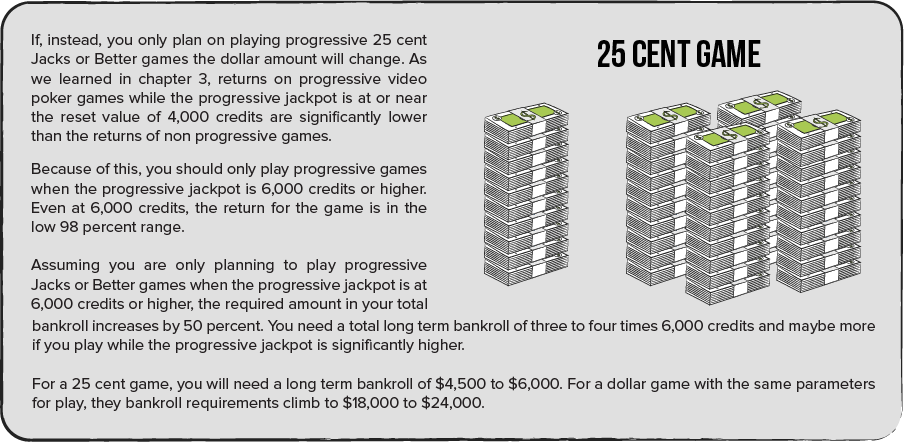
25 Cent Progressive Game

As you can see, the long term video poker bankroll requirements are quite large when you consider you are only playing $1.25 per hand on a 25 cent game and $5.00 per hand on a dollar video poker game.
![]()
LONG TERM VS TRIP AND SESSION BANKROLLS:
While the long term bankroll requirements can be significant, trip and session bankroll requirements can be drastically lower. The rule of thumb for long term video poker bankrolls is used primarily for video poker players who regularly go to the casinos. By regularly, I mean an average of two to three days per month or more. The long term bankroll has to be as large as it is to make sure you have enough to tide you over the inevitable losing streaks. Some of them can be quite long and severe, as with the player I mentioned in chapter 2.6. If this player had not been in possession of an adequate bankroll, his video poker play would probably have been over long before going 190,000 hands without a royal flush.
If you are a serious player who plans to regularly frequent casinos and play video poker, you need to acquire a long term bankroll. If, however, you are a casual player who only goes to casinos once or maybe twice a year, the bankroll requirements are significantly less stringent. In this case you can simply accumulate a trip bankroll, making sure you do so before each trip to the casino.
Long Term

![]()
TRIP BANKROLLS:
How much do you need for a trip bankroll?
Later in this chapter will be some carefully calculated bankroll sizes based on the particular video poker game or type of game you play, but one rule of thumb for a trip bankroll is to just bring what you can comfortably afford to lose. That (hopefully) will not happen, but if you should go broke, at least you can afford it.
If you want to take a little more time to determine how much to bring, consider the following.
You are going on a three day trip and you want to play about four hours per day on a 25 cent single play game. You play about 500 hands per hour. That means you will play 2,000 hands for each four hour day. At that rate, in three days you will play 6,000 hands. At $1.25 per hand you will run $7,500 through the machine.
TRIP
Does that number surprise you? Most people do not realize just how much money they actually run through a machine. While your average three day loss on a game that returns 99 percent will only be $75 or $25 a day, we learned in chapter 2.5 that variance can cause some very large swings in your video poker bankroll. You will want to have enough to ride through those inevitable loss cycles.
So, how much should your trip bankroll be?
If you play a low variance game such as Jacks or Better a good rule of thumb is to bring at least 10 percent of the money you will run through the machine. In the situation mentioned above, this amounts to $750. If you play a higher variance game such as Double Double Bonus Poker you should bring about one-sixth (or 16.67 percent) of the
money you will run through the game. In this case it amounts to $1,250. What if you do not have that much to bring? You certainly can bring less and hope you have a bit of luck, but realistically, if you do bring less you stand a decent chance of losing it all.
Ask yourself this question. “If I go broke, am I okay with no longer playing any video poker the rest of that trip?”
If not, it would be very wise to reduce the amount of play so it is no more than 10 times your bankroll on a low variance game to no more than six times your bankroll if it is a middle variance game. You may still lose all your money, but it is much less likely.
Those are the “rule of thumb” trip bankroll requirements.
![]()
SESSION BANKROLLS:
Now what about a session bankroll? How much should each one of those be?
Simple.
If you want to play the same amount each of the three days, bring one third of the trip bankroll with you to the casino each day. Bring only the amount you plan to play that day and no more. If your three day trip bankroll is $750, bring just $250 to the casino the first day. Leave the rest in the room safe. If you lose your first day’s session bankroll, stop playing for that day. Do not go into the safe and grab some of the next day’s stake.
Take a walk. Take a nap. Sit and people watch. But, do not play any more that day. That is how you make the most of your casino trip. It takes discipline, but it is well worth it.

![]()
KEY TAKEAWAYS
![]() A gambling bankroll is a totally separate sum of money that is used exclusively for gambling.
A gambling bankroll is a totally separate sum of money that is used exclusively for gambling.
![]() A good rule of thumb for a long term video poker bankroll is three to four times the pay for a royal flush.
A good rule of thumb for a long term video poker bankroll is three to four times the pay for a royal flush.
![]() A good rule of thumb for a trip bankroll is 10 percent to 16.67 percent of the total amount run through the game for a low or middle variance game respectively.
A good rule of thumb for a trip bankroll is 10 percent to 16.67 percent of the total amount run through the game for a low or middle variance game respectively.
![]() For a session bankroll split the trip bankroll into even amounts for each day. Play no more than that amount each day.
For a session bankroll split the trip bankroll into even amounts for each day. Play no more than that amount each day.
![]()

GAME DENOMINATION
The denomination of a video poker game is the amount of money that is counted as one credit. Game denominations can run from as little as one cent up to $100 or more. That is quite a range! Obviously the denomination of the game you play will impact you bankroll requirements. In most cases the impact of the game’s denomination on your bankroll for video poker is fairly straight forward. In other cases, not so much. Let’s take a look.

![]()
SINGLE PLAY NON PROGRESSIVE GAMES:
A single play non progressive video poker game is by far the simplest category to understand. In the previous section we learned some rules of thumb for determining the size of a bankroll for video poker. Whether you decide to play a 25 cent game, a 50 cent game, a dollar game or anything else; the same rule of thumb works. The bankroll for video poker game should be 10 percent of the money you will run through the game if it is a low variance game and one sixth of the money you will run through the game if it is a middle variance game.
Later in this chapter we will calculate some actual bankroll sizes using some computer software. All the calculations will use a 25 cent denomination game as the basis.
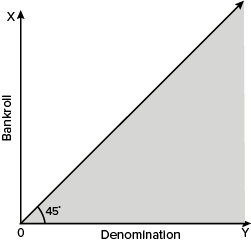
In order to determine the bankroll size for a different denomination, simply multiply the 25 cent bankroll by the ratio of the new denomination to 25 cents. For example, if the 25 cent video poker game’s bankroll was calculated at $100, to determine the bankroll size required for a dollar game, multiply the $100 by 1.00 and then divide it by .25; $100 X 1.00 / .25 = $400. Your bankroll for a dollar game needs to be $400. To determine the bankroll requirements for a five cent video poker game multiply $100 by .05 and divide by .25; $100 X .05 / .25 = $20. You bankroll for the nickel game needs to be $20.
There is always a direct correlation between the bankroll size for one denomination and the bankroll size for a different denomination of the same game.
![]()
SINGLE PLAY PROGRESSIVE GAMES:
Bankroll requirements for progressive games of different denominations are a bit less straight forward. Because the progressive jackpot amount increases as the game is played means that the strategy for playing the game also changes. As the strategy for playing the game changes, the variance changes. This is true because as the progressive jackpot increases the strategy will start to favor saving for the royal flush to the detriment of saving for more frequent smaller pays. These play changes cause the variance to increase because you are no longer hitting the lower paying but more frequent hands as often. And, as mentioned previously, the higher the variance, the larger the bankroll must be.
In section 4.5 below are examples of bankroll requirements for several different games and progressive jackpot sizes. For now, however, you can use a rule of thumb for determining your bankroll size. Because almost every progressive game has a reduced pay schedule when the game is at reset value, the bankroll requirements are a bit higher than a normal non progressive game with a decent return. Assuming you will be playing 2,000 hands (at 500 hands per hour for four hours) a good rule of thumb for a low variance game such as Jacks or Better is to have a bankroll of about 15 percent of the money you will run through the game. For a 25 cent game, 2,000 hands total $2,500 run through the game. A bankroll of $375 will give you a decent chance of being around for the entire four hours. For a moderate variance game such as Double Double Bonus Poker, a bankroll of 25 percent will be required. That amounts to $625 assuming you will play the
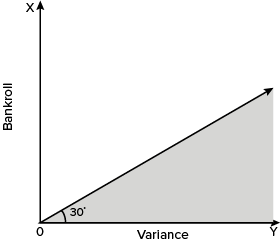

same 2,000 hands on a 25 cent game. Keep in mind that you will probably not be playing a progressive game with a high jackpot for very long meaning your bankroll size requirement may be somewhat diminished. Here is why that is the case. A bank of games with a high progressive jackpot becomes very popular. Additional players appear out of nowhere, flocking to the games to try their luck at hitting the high paying jackpot. The more players there are on the progressive bank, the more hands are played. The more hands that are played the sooner someone hits the jackpot. And, the jackpot is reset as soon as someone hits the royal flush. When that happens, you should move on to another, better paying game.
As with the non progressive games, the denomination of the game does not matter. The bankroll size for any progressive game will always be the same percentage (although it will be a higher percentage than a non progressive game) of the total amount run through the game. If you are playing a dollar game, the bankroll requirements will four times the bankroll needed to play a 25 cent game – assuming the same number of hands and the same number of credits in the progressive jackpot.
![]()
MULTIPLE PLAY GAMES:
As we saw in section 3.4, the variance of a multiple play video poker game increases as the number of plays increases. This increased variance affects the size of your video poker bankroll. In a single play video poker game the bankroll size increases as the variance increases. The bankroll size becomes a larger percentage of the money run through the video poker game as the variance increases.
With multiple play games, the bankroll requirements also increase as the number of plays increases. However, the size of the bankroll as a percentage of the money run though the game actually decreases a bit as the number of plays increases. As is the case in progressive games, the bankroll

requirements as a percentage of the total money run through the game is the same regardless of what denomination you play as long as the pay table is the same and you play the same number of hands. The dollar amount required for playing a dollar game will be four times the amount required to play a 25 cent game.
The only time bankroll requirements for video poker will be a different percentage of the money run through the game is if you play a different number of plays per hand. The bankroll required to run $5,000 through a single play dollar Jacks of Better game will be more than the bankroll required to run $5,000 through a 10 cent 10 play game, even though each total hand costs the same $5, there are 10 times as many hands played on the 10 cent game. Because of the lower denomination, the bankroll requires a smaller percentage of the total amount.
![]()
KEY TAKEAWAYS
![]() For single play video poker games, the bankroll required for different denominations is the same percentage of the total amount run through the game.
For single play video poker games, the bankroll required for different denominations is the same percentage of the total amount run through the game.
![]() The same is true of progressive games as long as the jackpot is the same size.
The same is true of progressive games as long as the jackpot is the same size.
![]() The same is also true of multiple play games as long as you play the same number of lines.
The same is also true of multiple play games as long as you play the same number of lines.
![]() The bankroll requirements for playing 10 lines of 10 cent video poker are less than for playing one line of dollar video poker even though you play the same total amount per hand.
The bankroll requirements for playing 10 lines of 10 cent video poker are less than for playing one line of dollar video poker even though you play the same total amount per hand.
![]()

IMPACT OF VARIANCE ON BANKROLL REQUIREMENTS
So far in this chapter you have learned about long term, trip, and session bankrolls and the effect that the denomination of the game has on bankroll requirements. In this section you will learn how variance affects your bankroll requirements.

![]()
HIGHER VARIANCE = LARGER BANKROLL SWINGS
= HIGHER BANKROLL REQUIRED
From the information in chapter 2 you know that the higher the variance the wilder the swings in your bankroll – both down and up. Earlier in this chapter you learned that when playing a low variance game such a Jack or Better, the rule of thumb for the trip or session bankroll size is to make it 10 percent of the total that you will play through the game during your trip or session. For a moderate variance game such as Double Double Bonus Poker, the trip or session bankroll needs to be about one sixth (16.67 percent) of the total amount run through the game. This gives you a real insight into the impact that variance has on your bankroll.
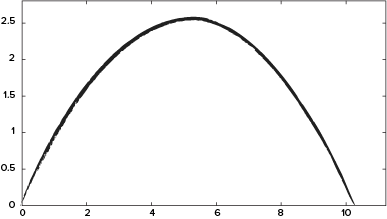
Now let us take a closer look at some specific bankroll requirements for several different games. Unless stated otherwise all of the results shown below are for four hours of play at 500 hands per hour for a total of 2,000 hands.
![]()
RISK OF RUIN:
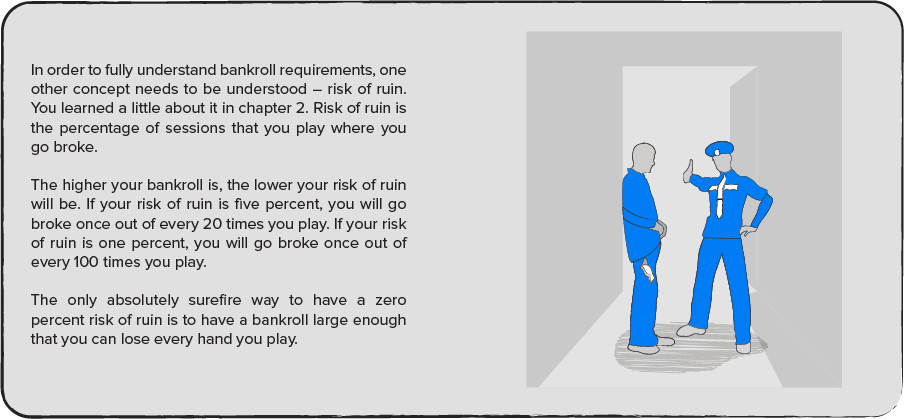
Each of the examples in this section has two different bankroll numbers given; one for a five percent risk of ruin and one for a one percent risk of ruin. You will notice that there can be quite a difference in the two numbers.
Think about what risk of ruin actually means to you. When asked, most gamblers say that they are okay with losing their entire session bankroll five percent of the time.
In reality, most players really hate losing their entire bankroll – even once. When looking at the bankroll requirements, be honest with yourself about how comfortable you are about going broke.
Personally, I hate going broke during even one playing session. Consequently, my bankroll is at least twice that of a bankroll with a one percent risk of ruin.

![]()
SOME SPECIFICS:
Okay, enough theory and preparation, let’s look at some numbers.
Since it is the most basic of video poker games, let’s take a look at the bankroll requirements for full pay (9/6) Jacks of Better. This game has a variance of 19.5 and a return of 99.54 percent.
This game has a low variance and a high return. In order to have enough money to play this game with a five percent risk of ruin (going broke one time out of 20) requires a bankroll of $252 – about 10 percent of the total amount run through the game in 2,000 hands ($2,500).
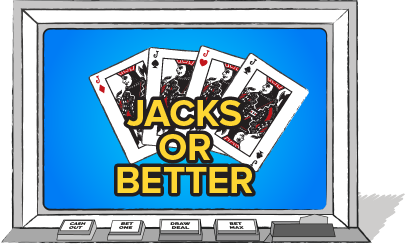
To reduce the chance of going broke to once in 100 sessions you will need a bankroll of $313. This is 12.5 percent of the total amount played and an increase of almost 24 percent over the bankroll requirements for a five percent risk of ruin.
Now let’s check the requirements for a game with a moderate variance – Double Bonus Poker. There are several different versions of this game, each with a different pay table. We will look at three of them here. They are the 10/7/5 full pay version (10 for 1 paid for a full house, 7 for 1 paid for a flush and 5 for 1 paid for a straight), the 10/6/5 version, and the 9/7/5 version. Each of these games has a different return and a different variance. Let’s look at how those differences affect the bankroll requirements.
The 10/7/5 version of Double Bonus Poker is a positive game. It may be rare to find such a game, but it is available in a few casinos in Las Vegas and possibly elsewhere. It returns 100.17 percent back to the player. It has a moderate variance of 28.25.
The 10/6/5 version returns only 98.88 percent to the player (a 1.3 percent drop) and has a variance of 30.40, slightly more than the full pay version.
The 9/7/5 version returns 99.11 to the player and has a variance of 28.5. Both of these numbers are better for the player than those of the 10/6/5 version.
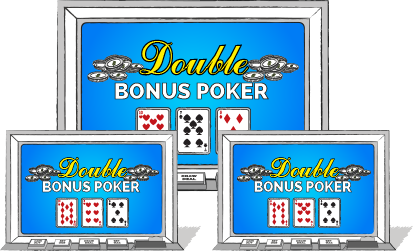
Both of the lower paying versions of Double Bonus poker can be readily found in most casinos.
The table below shows all the details of the bankroll requirements for these three versions of Double Bonus Poker for a 2,000 hand playing session on a 25 cent game. It also has a row to show the bankroll size for the low variance game of 9/6 Jacks or Better discussed previously.
Bankroll Requirements for 2,000 hands of 25 Cent Double Bonus Poker

Notice how the bankroll requirements increase or decrease as the variance increases or decreases. Also notice that the bankroll size for a one percent risk of ruin is significantly higher than that for a five percent risk of ruin.
Another interesting piece of information shown in this table is that even though the first game is a long term winner for player, there are still significant bankroll requirements. From the numbers in this table, it should be clear that variance is the major factor in determining your bankroll size for video poker. Consequently, you should keep variance foremost in your mind as you choose a video poker game you would like to play.
![]()
KEY TAKEAWAYS
![]() Variance is the key factor in determining a bankroll size.
Variance is the key factor in determining a bankroll size.
![]() Unless you have a large enough bankroll to lose every hand you play, risk of ruin is a factor in determining bankroll size.
Unless you have a large enough bankroll to lose every hand you play, risk of ruin is a factor in determining bankroll size.
![]() There are significant bankroll requirements even if the game is a positive one.
There are significant bankroll requirements even if the game is a positive one.
![]() When deciding how much risk you can tolerate, be honest with yourself. Most players think they can tolerate more than they actually can.
When deciding how much risk you can tolerate, be honest with yourself. Most players think they can tolerate more than they actually can.

![]()

MULTIPLE PLAY VIDEO POKER
You learned in chapter 3.4 that the variance of a multiple play game increases as the number of lines played increases. The variance of a single play game is lower than the variance of a three play game. The variance of a five play game is higher than the variance of a three play game, and so on. In this section you will find out specific video poker bankroll sizes for a couple of games at a different number plays for each game.
All games are 25 cent games. The bankroll is calculated on 1,000 hands being played. For each game we will show statistics for single play, three play, five play, and 10 play. The variance, total money run through the game, and the bankroll required for a five percent and a one percent risk of ruin will all be shown.
Let’s begin.
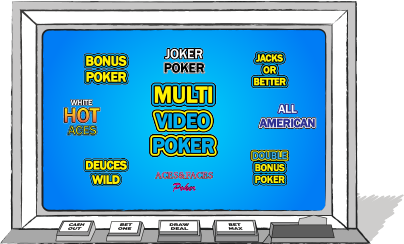
![]()
MULTIPLE PLAY JACKS OR BETTER VIDEO POKER
The first game we will look at is Jacks or Better. It is one of the lowest variance games available so it is a good one to start with.
The table below shows all the information related to a 25 cent 9/6 Jacks or Better game.
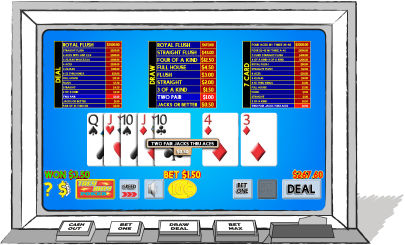
Bankroll Required for 1,000 Hands of 25 Cent 9/6 Jacks or Better

The information presented in the table above clearly shows:
![]() The variance increases as the number of plays increases.
The variance increases as the number of plays increases.
![]() The bankroll required increases as the variance increases.
The bankroll required increases as the variance increases.
![]() The bankroll required for a one percent risk of ruin is about 24 percent higher than the bankroll required for a five percent risk of ruin.
The bankroll required for a one percent risk of ruin is about 24 percent higher than the bankroll required for a five percent risk of ruin.
![]() The bankroll as a percent of the total dollars played, decreases as the number of plays increases.
The bankroll as a percent of the total dollars played, decreases as the number of plays increases.
![]()
MULTIPLE PLAY DOUBLE BONUS POKER
Next we will look at another popular multiple play game – Double Bonus Poker. Since the full pay (10/7/5 – 10 for 1 paid for a full house, 7 for 1 paid for a flush, and 5 for 1 paid for a straight) version is almost nonexistent in a multiple play format, we will use the 9/7/5 (9 for 1 paid for a full house, 7 for 1 paid for a flush and 5 for 1 paid for a straight) version instead for the bankroll calculations. As we did with the Jacks or Better game, the bankroll calculations will be based on 1,000 hands of a 25 cent denomination game. Shown in the table below are the results of those bankroll calculations.
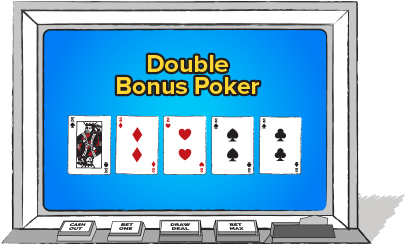
Bankroll Required for 1,000 Hands of 25 Cent 9/7/5 Double Bonus Poker

The results in this table should show no surprises.
![]() Because the base game has a higher variance (28.3 versus 19.5 for 9/6 Jacks or Better), the variance for the different multiple plays is also higher.
Because the base game has a higher variance (28.3 versus 19.5 for 9/6 Jacks or Better), the variance for the different multiple plays is also higher.
![]() Because the variance is higher, the bankroll requirements are also higher.
Because the variance is higher, the bankroll requirements are also higher.
![]() The bankroll required to have a one percent risk of ruin is about 20 percent higher than the bankroll for a five percent risk of ruin.
The bankroll required to have a one percent risk of ruin is about 20 percent higher than the bankroll for a five percent risk of ruin.
![]() The bankroll as a percentage of the total dollars played decreases as the number of plays increases.
The bankroll as a percentage of the total dollars played decreases as the number of plays increases.
![]()
SINGLE VERSUS MULTIPLE PLAY WITH SAME BET AMOUNT
You have seen how the bankroll requirements for video poker change with the variance and number of plays for the same denomination of play (which was 25 cents for the examples above).
But, what if you run the same amount through two games with different denominations?
What are the bankroll requirements for running $5,000 through a single play dollar game versus running $5,000 through a 10 play 10 cent game? In each case, each total hand will cost five dollars (50 cents per line with 10 lines versus five dollars per line for single play). For the purposes of this section, we will assume we are playing 1,000 hands. What will happen in these two scenarios?
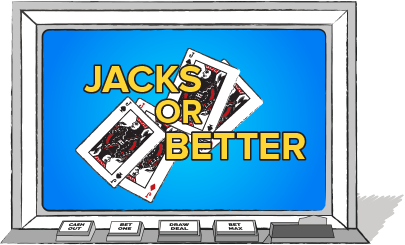
The bankroll required for the single play game is about $750 or about 15 percent of the total dollar amount run through the game. We know that the 10 play game has a higher variance.
Will it also have a higher bankroll requirement?
The answer (drum roll please) - in order to run $5,000 through a 10 cent, 10 play game you will need a bankroll of about $500 or 10 percent of the total run through the game. Even though the variance is higher for the 10 play game, the smaller base bet brings the bankroll requirement down to about two thirds of what is required for a dollar single line game.
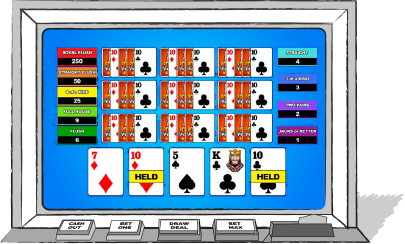
![]()
KEY TAKEAWAYS
![]() As the number of plays increases, the variance also increases.
As the number of plays increases, the variance also increases.
![]() Even though variance increases, the bankroll requirement as a percentage of the total dollars bet decreases as the number of plays increases.
Even though variance increases, the bankroll requirement as a percentage of the total dollars bet decreases as the number of plays increases.
![]() With the same amount played per hand, bankroll requirements are lower for a multiple play game of a lower denomination than a single play game.
With the same amount played per hand, bankroll requirements are lower for a multiple play game of a lower denomination than a single play game.
![]()

PROGESSIVE VIDEO POKER
You learned in chapter 3.5 that progressive video poker has one (the royal flush) or more (other high paying hands such as a four of a kind) jackpots that increase as the game is played. You also learned that as the progressive jackpot increases, the strategy to play the game changes so that more of the close decisions are decided in favor of saving for the higher paying and less frequent jackpot hand rather than some more frequent but lower paying hands.
You learned that as the strategy changes to favor the jackpot(s), the variance of the game also increases. In this section you will see actual bankroll requirements for a few different games and jackpot sizes. You will be able to see just how much the jackpot size affects bankroll requirements.

![]()
PROGRESSIVE JACKS OR BETTER
As we have done in previous examples, let us start with a low variance game. Jacks or Better has a low variance of 19.5. It is also generally available in most casinos. The 9/6 (9 for 1 for a full house and 6 for 1 for a flush) full pay single line game returns 99.54 percent. The progressive game has a jackpot for the royal flush that increases as the game is played. To fund this progressive jackpot, the pay for a full house and flush is reduced to 8/5 respectively from 9/6. This reduces the return of the game when it is at the royal flush reset value of 4,000 credits to 97.30 percent – about a two and a quarter percent decrease. The variance, when at reset value, is 19.32 – only slightly higher than the full pay non progressive game.
As in the previous section, all of the bankrolls shown here are based on playing a 25 cent game at $1.25 per hand and playing for four hours at a rate of 500 hands per hour for a total of 2,000 hands and $2,500 run through the game.
Even though you should probably never play a progressive game with the jackpot at the reset value, I will show you the bankroll requirements. This gives a base that you can compare against other bankrolls.
The bankroll requirements for playing 2,000 hands of 25 cent 8/5 Jacks of Better ($2,500 total play) with a 4,000 credit royal flush are:


![]() The variance increases as the number of plays increases.
The variance increases as the number of plays increases.
![]() The bankroll required increases as the variance increases.
The bankroll required increases as the variance increases.
The bankroll size for 9/6 Jacks or Better using all the same play characteristics is $250 instead of the $297 in the 8/5 game. The bankroll requirement is significantly higher for the 8/5 game due to the much lower return compared to the 9/6 game.
Now we will take a look at the bankroll requirements for the 8/5 progressive Jacks or Better game when the royal flush jackpot is at 6,000 credits ($1,500 – one and one half times reset value) and when it is at 8,000 credits ($2,000 – twice reset value). The table below details the information. All the results assume that you are the only person playing the progressive bank of games, so you are given the maximum number of hands when calculating the bankroll size.
Bankroll Requirements for 2,000 hands of 25 Cent 8/5 Progressive Jacks or Better

The information presented in the table above clearly shows:
![]() The return of the game goes up about one half percent for every 1,000 additional credits in the progressive royal flush jackpot.
The return of the game goes up about one half percent for every 1,000 additional credits in the progressive royal flush jackpot.
![]() When the royal progressive jackpot is at 8,000 credits, the return for the game is about the same as non progressive 9/6 Jacks or Better. The variance however is about four times that of 9/6 Jack or Better.
When the royal progressive jackpot is at 8,000 credits, the return for the game is about the same as non progressive 9/6 Jacks or Better. The variance however is about four times that of 9/6 Jack or Better.
![]() The dramatic increase in variance as the royal flush jackpot increases and strategy changes to favor the higher amount while disregarding lower paying hands.
The dramatic increase in variance as the royal flush jackpot increases and strategy changes to favor the higher amount while disregarding lower paying hands.
![]() The steady rise in the bankroll requirements as the variance increases.
The steady rise in the bankroll requirements as the variance increases.
![]() The significant increase in the size of your bankroll in order to achieve a one percent risk of ruin: 20 percent at 4,000 credits, 19.5 percent at 6,000 credits and 19 percent at 8,000 credits.
The significant increase in the size of your bankroll in order to achieve a one percent risk of ruin: 20 percent at 4,000 credits, 19.5 percent at 6,000 credits and 19 percent at 8,000 credits.
When the royal jackpot reaches 8,700 credits, the return reaches 100 percent. The variance however also climbs to 96.27.
![]()
PROGRESSIVE DOUBLE DOUBLE BONUS POKER
The dramatic increase in bankroll shown above is for a relatively low variance base game. What happens to the bankroll requirements with a moderate variance progressive game such as Double Double Bonus. The table below has the answers. As with the Jacks or Better game above, the results are for playing 2,000 hands of a 25 cent game for a total outlay of $2,500. Also as in the table above, the results are calculated for progressive royal flush amounts of 4,000 credits, 6,000 credits and 8,000 credits.
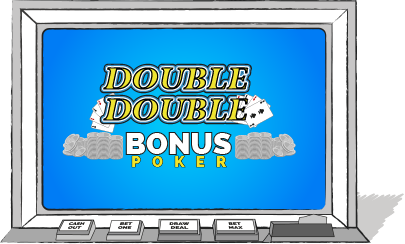
 Bankroll Requirements for 2,000 hands of 25 Cent 8/5 Progressive Double Double Bonus Poker
Bankroll Requirements for 2,000 hands of 25 Cent 8/5 Progressive Double Double Bonus Poker

Notice how much higher the variances for these games are. Also, notice how the higher variance translates into higher bankroll requirements. As with the 8,000 credit jackpot on the game of Jacks or Better, the return at 99.06 is very close to the full pay non progressive version of the game. As with the progressive Jacks or Better game, for each additional 1,000 credits in the progressive royal flush jackpot, the return increases by about one half percent. This progressive game becomes positive when the progressive jackpot reaches about 9,550 credits. The variance at this level reaches 140.32, a brutally high sum.
![]()
KEY TAKEAWAYS
![]() The lower returns of progressive video poker games when the jackpot is at reset value causes the variance to rise, which in turn raises the bankroll requirement.
The lower returns of progressive video poker games when the jackpot is at reset value causes the variance to rise, which in turn raises the bankroll requirement.
![]() For each progressive royal flush jackpot increase of 1,000 credits, the return of the game increases by about one half percent.
For each progressive royal flush jackpot increase of 1,000 credits, the return of the game increases by about one half percent.
![]() The actual bankroll requirements for progressive video poker may be less because you only play the game when the progressive jackpot is at least 6,000 credits. If you or another player hits a royal flush, you will stop playing the progressive. Therefore you may not play the 2,000 hands that we used to calculate the bankroll size.
The actual bankroll requirements for progressive video poker may be less because you only play the game when the progressive jackpot is at least 6,000 credits. If you or another player hits a royal flush, you will stop playing the progressive. Therefore you may not play the 2,000 hands that we used to calculate the bankroll size.
![]()
CHAPTER SUMMARY
In this chapter you learned all about what it takes to determine the proper bankroll size. Yu learned that a bankroll is a totally separate sum of money to be used for gambling. You learned the difference between a long term bankroll, a trip bankroll and a session bankroll. You learned some rules of thumb to help you estimate the proper bankroll. When it comes to playing different denominations of video poker, you found out that the bankroll requirements change in direct proportion to the denomination of the game in most cases. You saw just how strong variance influences your bankroll size. Risk of ruin is something all gamblers must face when determining their bankroll size. All video poker games have a variance, even those that give the player an advantage. You learned that the number of plays in a multiple play game and the size of the progressive jackpot influence the size of your required bankroll. In the next chapter you will learn what type of video poker game will be the best for you to play and why.
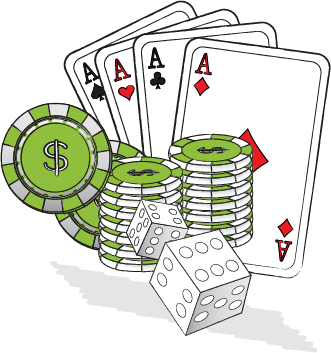
![]()
TEST YOURSELF
See if you can answer these questions based on the information presented in Chapter 4.
![]() True or False - A gambling bankroll can be supplemented by going to the ATM if you run short while in the casino.
True or False - A gambling bankroll can be supplemented by going to the ATM if you run short while in the casino.
![]() True or False - A good rule of thumb for determining your long term bankroll size is to make it three to four times the amount you win for hitting a royal flush.
True or False - A good rule of thumb for determining your long term bankroll size is to make it three to four times the amount you win for hitting a royal flush.
![]() If the bankroll needed to play a certain number of hands on a 25 cent non progressive game is $250, how much will you need if you want to play the same number of hands on a dollar game?
If the bankroll needed to play a certain number of hands on a 25 cent non progressive game is $250, how much will you need if you want to play the same number of hands on a dollar game?
![]() What does a five percent risk of ruin mean?
What does a five percent risk of ruin mean?
![]() How can you guarantee you will not go broke playing video poker?
How can you guarantee you will not go broke playing video poker?
![]() True or False - The more lines you play on a multiple play video poker game the lower the variance because by playing multiple lines you get to the long run more quickly.
True or False - The more lines you play on a multiple play video poker game the lower the variance because by playing multiple lines you get to the long run more quickly.
![]() True or False - You can play a progressive video poker game and expect the same return over the long run regardless of the size of the progressive jackpot.
True or False - You can play a progressive video poker game and expect the same return over the long run regardless of the size of the progressive jackpot.
![]() True or False - You bring a large enough bankroll to play 2,000 hands of progressive video poker. You find a bank of games with a very high progressive amount. It is likely you will lose your entire bankroll because of the high variance.
True or False - You bring a large enough bankroll to play 2,000 hands of progressive video poker. You find a bank of games with a very high progressive amount. It is likely you will lose your entire bankroll because of the high variance.
![]() You plan on playing 1,000 hands of 25 cent Jacks or Better. How much does the standard rule of thumb say you should have for a bankroll?
You plan on playing 1,000 hands of 25 cent Jacks or Better. How much does the standard rule of thumb say you should have for a bankroll?
![]() True or False - The two most important factors in determining your bankroll size is the game’s denomination and variance.
True or False - The two most important factors in determining your bankroll size is the game’s denomination and variance.
![]()
ANSWERS
![]() False. You should never go to an ATM or use casino credit to supplement your bankroll. Should you lose it all you should quit playing.
False. You should never go to an ATM or use casino credit to supplement your bankroll. Should you lose it all you should quit playing.
![]() True
True
![]() $1,000. One dollar is four times 25 cents, so you will need four times the bankroll to play the dollar game.
$1,000. One dollar is four times 25 cents, so you will need four times the bankroll to play the dollar game.
![]() It means that you will lose five percent of the sessions you play. In one out of 20 sessions you will go lose your entire gambling stake.
It means that you will lose five percent of the sessions you play. In one out of 20 sessions you will go lose your entire gambling stake.
![]() The only way to guarantee you will not go broke playing video poker is to bring enough money to pay for every hand you will play.
The only way to guarantee you will not go broke playing video poker is to bring enough money to pay for every hand you will play.
![]() False. Variance for multiple play video poker is always higher that its single play counterpart.
False. Variance for multiple play video poker is always higher that its single play counterpart.
![]() False. Since the return for progressive games is lowered, you will lose more quickly at a progressive game where the jackpot is not at least one and one half times the amount of a non progressive game.
False. Since the return for progressive games is lowered, you will lose more quickly at a progressive game where the jackpot is not at least one and one half times the amount of a non progressive game.
![]() False. Though it is technically possible to lose the entire bankroll, it is more likely someone will hit the royal flush and the jackpot will be reset to 4,000 credits before you do so. You should then stop playing as the house edge is too high.
False. Though it is technically possible to lose the entire bankroll, it is more likely someone will hit the royal flush and the jackpot will be reset to 4,000 credits before you do so. You should then stop playing as the house edge is too high.
![]() $125. The rule of thumb for a low variance game is to have 10 percent of the total amount you will play through the game. $1.25 times 1,000 hands equals $1,250. 10 percent of that is $125.
$125. The rule of thumb for a low variance game is to have 10 percent of the total amount you will play through the game. $1.25 times 1,000 hands equals $1,250. 10 percent of that is $125.
![]() True
True
![]()





